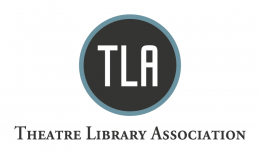ASTR/TLA 2016 Conference
Summary of TLA Plenary and TLA Tour
TLA Conference Plenary
The Theatre Library Association once again presented a successful plenary session at the 2016 National ASTR/TLA Conference, which was held in Minneapolis, MN, November 3-6. This year’s conference theme was “Trans-“ and it focused upon how that prefix – “signifies a blending, while it recognizes the complexities of . . . interweavings and raises questions about historical desires to unravel or untangle.” The theme fostered a wide array of interesting performances, working groups, plenaries and other events. In keeping with the conference theme, the TLA Plenary was entitled, “Trans(in)formation,” and it focused upon the way in which performing artists, archivists, librarians, and historians work to “unravel and untangle” complexities surrounding the collection, preservation, and use of theatrical primary source materials.
Several strong submissions were received in response to the Call for Papers circulated by co-chairs Matt DiCintio and Beth Kattelman, and ultimately the following papers were chosen for the panel:
“From Private Basements to the Public Archives: Ernie McClintock’s Jazz Acting Collection” – Elizabeth M. Cizmar, Bucknell University & Tufts University
“Translating the Stage: Digital Theatricality in Live Broadcast Theatre” — Lindsay Brandon Hunter, University at Buffalo, SUNY
“Transitioning to Big Data: Theatre Studies in the 21st Century” – Nancy Friedland, Librarian for Film Studies and Performing Arts, Columbia University
In her presentation, Elizabeth Cizmar discussed the experience of discovering and working with the Ernie McClintock papers, which consist of personal papers, correspondences, and audiovisual material of the director and acting teacher who shaped the lives of hundreds of actors nationwide. This unsung hero of the American theatre trained actors from 1966 to 2003 and developed the Jazz Acting technique, which would influence generations of Black actors and artists, including the prolific Tupac Shakur. The majority of his papers currently reside in the basement of an Arlington, Virginia house, a trove of materials which Cizmar gained access to through working with McClintock’s pupils, friends and family members.
Lindsay Brandon Hunter’s paper examined the process by which theatrical performance is rendered digitally for simultaneous broadcast on cinema screens. Using the National Theatre’s “NT Live” series as a case study, she discussed the ways in which the digital transmission of a theatrical production strives to maintain its fidelity to the “live” experience, while still attempting to create a high-quality, remote, digital experience. Hunter focused specifically upon how the act of recording theatre for digital broadcast intervenes in what is prioritized and communicated to audiences who are watching the mediated version of the event, and she also touched upon how the digital techniques used to record the production can influence—or interfere with—the experience of the performers and audience members who are involved in the live event.
Unfortunately, Nancy Friedland was unable to participate due to extenuating circumstances. The other two panelists, however, presented insightful and provocative papers that provoked engaged discussion among the attendants. As Matt DiCintio was also unable to attend the conference, Beth Kattelman served as the onsite plenary chair.
TLA Sponsored Theatre Tour
As part of the 2016 conference, TLA once again sponsored a tour to a local theatre. This year the tour took participants to Minneapolis’s Guthrie Theater. The tour was organized by Beth Kattelman (TLA Representative to the National Conference Committee) and Matt DiCintio (TLA Board Member). Approximately thirty participants took advantage of the opportunity, led by Lana Aylesworth, the Guthrie Theater’s Tour Coordinator. Ms. Aylesworth took the group on a fascinating excursion through the theatres and the backstage areas of the Guthrie, sharing many fun facts and anecdotes along the way. Tour participants were treated to views of many areas that are usually off-limits to the public, including the costume shop, the wig room, and the scene shop, where scenic artists were carving foam set pieces for an upcoming production of James Goldman’s play, The Lion in Winter. Response to the tour was extremely positive, with many participants choosing to spend additional time exploring the beautiful lobby and other public areas of the Guthrie after the official tour concluded.
Submitted by Beth Kattelman

